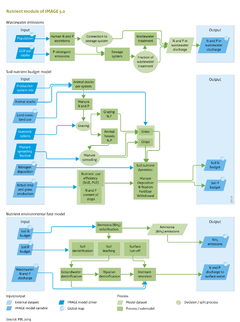Nutrients/Policy issues: Difference between revisions
Jump to navigation
Jump to search
m (RinekeOostenrijk moved page Nutrient balances/Policy issues to Nutrients/Policy issues without leaving a redirect) |
No edit summary |
||
| Line 1: | Line 1: | ||
{{ComponentPolicyIssueTemplate | {{ComponentPolicyIssueTemplate | ||
|Description=Under | |Description=Under baseline scenarios of IMAGE, N surpluses generally increase. For example, in the Rio+20 baseline scenario, the N surplus increases by 35% globally in the period 2002-2050 (Figure below). This is the result of decreasing trends in North America, Western Europe and Japan as a result of increasing nutrient use efficiency, and stabilisation in India. In all other regions, N surpluses increase, particularly in Sub-Saharan Africa and Southeastern Asia as a result of increasing fertilizer use to halt soil nutrient depletion (Figure below). The situation is similar for P, with large increases in developing countries. | ||
|Example=Extensification, increased feed efficiency and reduced ammonia emissions from stables (cases EX, FE and ST) have minor effects on the global soil N budget. However, better integration of animal manure in crop production systems (IM), primarily in industrialised countries, and a change in the human diet with poultry replacing ruminant meat (DI) would have major effects on the global soil N budget. | |Example=Extensification, increased feed efficiency and reduced ammonia emissions from stables (cases EX, FE and ST) have minor effects on the global soil N budget. However, better integration of animal manure in crop production systems (IM), primarily in industrialised countries, and a change in the human diet with poultry replacing ruminant meat (DI) would have major effects on the global soil N budget. | ||
Revision as of 18:15, 20 May 2014
Parts of Nutrients/Policy issues
| Component is implemented in: |
| Components: |
| Related IMAGE components |
| Projects/Applications |
| Key publications |
